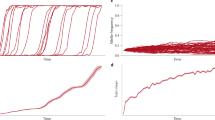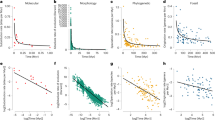Abstract
Recent evidence suggests the frequent occurrence of a simple non-Darwinian (but non-Lamarckian) model for the evolution of adaptive phenotypic traits, here entitled the plasticity–relaxation–mutation (PRM) mechanism. This mechanism involves ancestral phenotypic plasticity followed by specialization in one alternative environment and thus the permanent expression of one alternative phenotype. Once this specialization occurs, purifying selection on the molecular basis of other phenotypes is relaxed. Finally, mutations that permanently eliminate the pathways leading to alternative phenotypes can be fixed by genetic drift. Although the generality of the PRM mechanism is at present unknown, I discuss evidence for its widespread occurrence, including the prevalence of exaptations in evolution, evidence that phenotypic plasticity has preceded adaptation in a number of taxa and evidence that adaptive traits have resulted from loss of alternative developmental pathways. The PRM mechanism can easily explain cases of explosive adaptive radiation, as well as recently reported cases of apparent adaptive evolution over ecological time.
This is a preview of subscription content, access via your institution
Access options
Subscribe to this journal
Receive 12 print issues and online access
$259.00 per year
only $21.58 per issue
Buy this article
- Purchase on Springer Link
- Instant access to full article PDF
Prices may be subject to local taxes which are calculated during checkout

Similar content being viewed by others
References
Aubret F, Shine R (2009). Genetic assimilation and the postcolonization erosion of phenotypic plasticity in island tiger snakes. Curr Biol 19: 1932–1936.
Baldwin JM (1896). A new factor in evolution. Am Nat 30: 441–451. 536–553.
Baublys KK (1975). Comments on some recent analyses of functional statements in biology. Philos Sci 42: 469–486.
Beharka AA, Nagaraja TG, Morill JL, Kennedy GA, Klemm RD (1998). Effects of form of the diet on anatomical, microbial, and fermentive development of the rumen of neonatal calves. J Dairy Sci 81: 1946–1955.
Belyaev DK (1979). Destabilizing selection as a factor in domestication. J Hered 70: 301–308.
Blackburn TM, Lockwood JL, Cassey P (2009). Avian Invasions: The Ecology and Evolution of Exotic Birds. Oxford University Press: New York.
Carroll SB (2008). Evo-devo and an expanding evolutionary synthesis: a genetic theory of morphological evolution. Cell 134: 25–36.
Carroll SP, Hendry AP, Reznick DN, Fox CW (2007). Evolution on ecological time-scales. Functional Ecol 21: 387–393.
Causton HC, Ren B, Koh SS, Harbison CT, Kanin E, Jennings EG et al. (2001). Remodeling of yeast genome expression in response to environmental change. Mol Biol Cell 12: 323–337.
Chapman RW, Mancia A, Beal M, Veloso A, Rathburn C, Blair A et al. (2011). The transcriptomic responses of the eastern oyster, Crassostrea virginica, to environmental conditions. Mol Ecol 20: 1431–1449.
Chevin L-M, Lande R, Mace GM (2010). Adaptation, plasticity, and extinction in a changing environment: towards a predictive theory. PLoS Biol 8: e1000357.
Chong S, Whitelaw E (2004). Epigenetic germline inheritance. Curr Opin Genet Dev 14: 692–696.
Clutton-Brock TH (1988). Reproductive Success: Studies on Individual Variation in Contrasting Breeding Systems. University of Chicago Press: Chicago.
Collins S, Bell G (2006). Evolution of natural algal populations at elevated CO2 . Ecol Lett 9: 129–135.
Crispo E (2007). The Baldwin effect and genetic assimilation: revisiting two mechanisms of evolutionary change mediated by phenotypic plasticity. Evolution 61: 2469–2479.
Darwin C (1859). The Origin of Species. John Murray: London.
Erwin DE (1998). The end and the beginning: recoveries from mass extinctions. Trends Ecol Evol 13: 344–349.
Erwin DH, Davidson EH (2009). The evolution of hierarchical gene regulatory networks. Nature Rev Genet 10: 141–148.
Feinberg AP (2007). Phenotypic plasticity and the epigenetics of human disease. Nature 447: 433–440.
Fisher RA (1930). The Genetical Theory of Natural Selection. Oxford University PressL: Oxford.
Gilbert SF, Epel D (2009). Ecological Developmental Biology. Sinauer Associates: Sunderland MA.
Gould SJ, Lewontin RC (1979). The spandrels of San Marco and the Panglossian paradigm: a critique of the adaptationist programme. Proc R Soc Lond B Biol Sci 205: 581–598.
Gould SJ, Vrba ES (1982). Exaptation–a missing term in the science of form. Paleobiology 8: 4–15.
Grant V (1963). The Origin of Adaptations. Columbia University Press: New York.
Hairston Jr NG, Ellner SP, Geber MA, Yoshita T, Fox JA (2005). Rapid evolution and the convergence of ecological and evolutionary time. Ecol Lett 8: 1114–1127.
Hawkins T (1950). Opening of milk bottles by birds. Nature 165: 435–436.
Hernandez RD, Kelley JL, Elyashiv E, Melton SC, Auton A, McVean G et al. (2011). Classic selective sweeps were rare in recent human evolution. Science 331: 920–924.
Hudson LG, Zeinelden R, Stack MS (2008). Phenotypic plasticity of neoplastic ovarian epithelium: unique cadherin profiles in tumor progression. Clin Exp Metastasis 25: 643–655.
Hudson RR, Kreitman M, Aguadé M (1987). A test of neutral molecular evolution based on nucleotide data. Genetics 116: 153–159.
Hughes AL (1985). Male size, mating success, and mating strategy in the mosquitofish Gambusia affinis (Poeciliidae). Behav Ecol Sociobiol 17: 271–278.
Hughes AL (1999). Adaptive Evolution of Genes and Genomes. Oxford University Press: New York.
Hughes AL (2005). Evidence for abundant slightly deleterious polymorphisms in bacterial populations. Genetics 169: 553–558.
Hughes AL (2007). Looking for Darwin in all the wrong places: the misguided quest for positive selection at the nucleotide sequence level. Heredity 99: 364–373.
Hughes AL (2008a). The origin of adaptive phenotypes. Proc Natl Acad Sci USA 105: 13193–19194.
Hughes AL (2008b). Near neutrality: leading edge of the neutral theory of molecular evolution. Ann NY Acad Sci 1133: 162–179.
Hughes AL, Friedman R (2005). Loss of ancestral genes in the genomic evolution of Ciona intestinalis. Evol Devel 7: 196–200.
Hughes AL, Friedman R, Rivailler P, French JO (2008). Synonymous and nonsynonymous polymorphisms and divergences in bacterial genomes. Mol Biol Evol 25: 2199–2209.
Hughes AL, Packer B, Welsch R, Bergen AW, Chanock SJ, Yeager M (2003). Widespread purifying selection at polymorphic sites in human protein-coding loci. Proc Natl Acad Sci USA 100: 15754–15757.
Iacovitti L, Lee J, Joh TH, Reis DJ (1987). Expression of tyrosine hydroxylase in neurons of cultured cerebral cortex: evidence for phenotypic plasticity in neurons of the CNS. J Neurosci 7: 1264–1270.
Jeffrey WR (2001). Cavefish as a model system in evolutionary developmental biology. Devel Biol 231: 1–12.
Jensen JD, Thornton KR, Bustamente CD, Aquadro CF (2007). On the utility of linkage disequilibrium as a statistic for identifying targets of positive selection in nonequilibrium populations. Genetics 176: 2371–2379.
Kimura M (1976). How genes evolve; a population geneticist's view. Ann Génét 19: 153–168.
Kimura M (1983). The Neutral Theory of Molecular Evolution. Cambridge University Press: Cambridge.
Kimura M, Ohta T (1974). On some principles governing molecular evolution. Proc Natl Acad Sci USA 71: 2848–2852.
Kolar CS, Lodge DM (2001). Progress in invasion biology: predicting invaders. Trends Ecol Evol 16: 199–204.
Lande R (2009). Adaptation to an extraordinary environment by evolution of phenotypic plasticity and genetic assimilation. J Evol Biol 22: 1435–1446.
Ledon-Rettig CC, Pfennig DW, Nascone-Yoder N (2008). Ancestral variation and the potential for genetic accommodation in larval amphibians: implications for the evolution of novel feeding strategies. Evol Devel 10: 316–325.
Lesk AM (2008). Introduction to Bioinformatics, 3rd edn. Oxford University Press: New York.
Lewontin RC (1957). The adaptations of populations to varying environments. Cold Spring Harb Symp Quant Biol 22: 395–408.
Liman ER, Innan H (2003). Relaxed selective pressure on an essential component of pheromone transduction in primate evolution. Proc Natl Acad Sci USA 100: 3328–3332.
Lindquist S (1986). The heat-shock response. Annu Rev Biochem 55: 1151–1191.
Lynch M (2007). The Origins of Genome Architecture. Sinauer: Sunderland MA.
McBride CS (2007). Rapid evolution of smell and taste receptor genes during host specialization in Drosophila sechellia. Proc Natl Acad Sci USA 104: 4996–5001.
McClean CY, Reno PL, Pollen AA, Bassan AI, Capellini TD, Guenther C et al. (2011). Human-specific loss of regulatory DNA and the evolution of human-specific traits. Nature 471: 216–219.
McDonald JH, Kreitman M (1991). Adaptive protein evolution at the Adh locus in Drosophila. Nature 351: 114–116.
McKechnie AE, Freckleton RP, Jetz W (2006). Phenotypic plasticity in the scaling of avian basal metabolic rate. Proc R Soc Lond B 273: 931–937.
McKinney ML, Lockwood JL (1999). Biotic homogenization: a few winners replacing many losers in the next mass extinction. Trends Ecol Evol 14: 450–453.
Mita T, Tanabe K, Kita K (2009). Spread and evolution of Plasmodium falciparum drug resistance. Parasitol Int 58: 201–209.
Mittelbach GG, Osenberg CW, Wainwright PC (1999). Variation in feeding morphology between pumpkinseed populations: phenotypic plasticity or evolution? Evol Ecol Research 1: 111–128.
Moczek AP (1998). Horn polyphenism in the beetle Onthophagus Taurus: larval diet quality and plasticity in parental investment determine adult body size and male horn morphology. Behav Ecol 9: 636–641.
Moczek AP, Sultan S, Foster S, Ledón-Rettig, Dworkin I, Nijhout HF et al. (2011). The role of developmental plasticity in evolutionary innovation. Proc R Soc Lond B 278: 2705–2713.
Moyle RG, Filardi CE, Smith CE, Diamond J (2009). Explosive Pleistocene diversification and hemispheric expansion of a ‘great speciator’. Proc Natl Acad Sci USA 106: 1863–1868.
Myers N, Knoll AH (2001). The biotic crisis and the future of evolution. Proc Natl Acad Sci USA 98: 5389–5392.
Nei M (1987). Molecular Evolutionary Genetics. Columbia University Press: New York.
Nei M (2005). Selectionism and neutralism in molecular evolution. Mol Biol Evol 22: 2318–2342.
Nei M (2007). The new mutation theory of phenotypic evolution. Proc Natl Acad Sci USA 104: 12235–12242.
Nei M, Suzuki Y, Nozawa M (2010). The neutral theory of molecular evolution in the genomic era. Annu Rev Genomics Hum Genet 11: 265–289.
Nijhout HF (2003). Development and evolution of adaptive polyphenisms. Evol Devel 5: 9–18.
Peyton SR, Kim PD, Ghajar CM, Seliktar D, Putnam AJ (2008). Effects of matrix stiffness and RhoA on the phenotypic plasticity of smooth muscle cells in a 3-D biosynthetic hydrogel system. Biomaterials 29: 2597–2607.
Pfennig DW, Wund MA, Snell-Rood EC, Cruickshank T, Schlichting CD, Moczek AP (2010). Phenotypic plasticity's impacts on diversification and speciation. Trends Ecol Evol 25: 459–467.
Pigliucci M, Murren CJ (2003). Genetic assimilation and a possible evolutionary paradox: can macroevolution sometimes be so fast as to pass us by? Evolution 57: 1455–1464.
Pigliucci M, Murren CJ, Schlichting CD (2006). Phenotypic plasticity and evolution by genetic assimilation. J Exp Biol 209: 2362–2367.
Price TD, Qvarnström A, Irwin DE (2003). The role of phenotypic plasticity in driving genetic evolution. Proc R Soc Lond B Biol Sci 270: 1433–1440.
Reeve HK, Sherman PW (1993). Adaptation and the goals of evolutionary research. Quart Rev Biol 68: 1–68.
Reznick DN, Ghalambor CK (2001). The population ecology of contemporary adaptations: what empirical studies reveal about the conditions that promote adaptive evolution. Genetica 112–113: 183–198.
Richards EJ (2006). Inherited epigenetic variation–revisiting soft inheritance. Nat Rev Genet 7: 395–401.
Rivero A, Vézilier J, Weill M, Read AF, Gandon S (2010). Insecticide control of vector-borne diseases: when is insecticide resistance a problem? PLoS Pathog 6: e1001000.
Sabeti PC, Schaffner SK, Fry B, Lohmueller J, Varilly P, Shamovsky O et al. (2006). Positive natural selection in the human lineage. Science 312: 1614–1620.
Sax DV, Brown JH (2000). The paradox of invasion. Global Ecol Biogeogr 9: 363–371.
Schlichting CD, Smith H (2002). Phenotypic plasticity: linking molecular mechanisms with evolutionary outcomes. Evol Ecol 16: 189–211.
Schluter D, Grant PR (1984). Ecological correlates or morphological evolution in a Darwin's finch, Geospiza diffilis. Evolution 38: 865–869.
Schoener TW (2011). The newest synthesis: understanding the interplay of evolutionary and ecological dynamics. Science 331: 426–429.
Slijper EJ (1942a). Biologic-anatomical investigations on the bipedal gait and upright posture in mammals, with special reference to a little goat, born without forelegs. I. Proc Koninklijke Nederlandse Akad Wetenschappen 45: 288–295.
Slijper EJ (1942b). Biologic-anatomical investigations on the bipedal gait and upright posture in mammals, with special reference to a little goat, born without forelegs. II. Proc Koninklijke Nederlandse Akad Wetenschappen 45: 407–415.
Sturmbauer C (1998). Explosive speciation in the African Great Lakes: a dynamic model of adaptive radiation. J Fish Biol 53: 18–36.
Van Bocxlaer I, Loader SP, Roelants K, Biju SD, Menegon M, Bossuyt F (2010). Gradual adaptation toward a range-expansion phenotype initiated the global radiation of toads. Science 327: 679–682.
Van Kleunen M, Fischer M (2005). Constraints on the evolution of adaptive phenotypic plasticity in plants. New Phytol 166: 49–60.
Via S, Gomulkiewicz R, de Jong G, Scheiner SM, Schlichting CD, Van Tienderen P (1995). Adaptive phenotypic plasticity: consensus and controversy. Trends Ecol Evol 10: 212–217.
Vissa VD, Brennan PJ (2001). The genome of Mycobacterium leprae: a minimal mycobacterial gene set. Genome Biol 2001 2: reviews1023.1–1023.8.
Waddington CH (1953). Genetic assimilation of an acquired character. Evolution 7: 118–126.
Wang X, Thomas SD, Zhang J (2004). Relaxation of selective constraint and loss of function in the evolution of human bitter taste receptor genes. Human Mol Genet 13: 2671–2678.
West-Eberhard MJ (1986). Alternative adaptations, speciation, and phylogeny (A Review). Proc Natl Acad Sci USA 83: 1388–1392.
West-Eberhard MJ (2003). Developmental Plasticity and Evolution. Oxford University Press: New York.
West-Eberhard MJ (2005). Developmental plasticity and the origin of species differences. Proc Natl Acad Sci USA 102: 6543–6549.
West-Eberhard MJ, Smith JA, Winter C (2011). Photosynthesis reorganized. Science 332: 311–312.
Willi Y, van Buskirk J, Hoffmann AA (2006). Limits to the adaptive potential of small populations. Annu Rev Ecol Evol Syst 37: 433–458.
Williamson MH, Fitter A (1996). The characters of successful invaders. Biol Conserv 78: 163–170.
Wund MA, Baker JA, Clancy B, Golub JL, Foster SA (2008). A test of the ‘flexible stem’ model of evolution: ancestral plasticity, genetic accommodation, and morphological divergence in the threespine stickleback radiation. Am Nat 172: 449–462.
Yacoby S (2005). The phenotypic plasticity of myeloma plasma cells as expressed by dedifferentiation into an immature, resilient, and apoptosis-resistant phenotype. Clin Cancer Res 11: 7599–7606.
Yang Z, Nielsen R, Goldman N, Pedersen AM (2000). Codon-substitution models for heterogeneous selection pressure at amino acid sites. Genetics 155: 431–449.
Yeh PJ, Price TD (2004). Adaptive phenotypic plasticity and the successful colonization of a novel environment. Am Nat 164: 531–542.
Youngson NA, Chong S, Whitelaw E (2010). Gene silencing is an ancient means of producing multiple phenotypes from the same genotype. Bioessays 33: 95–99.
Zhang J, Wagh P, Guay D, Sanchez-Pulido L, Padhi BK, Korzh V et al. (2010). Loss of fish actinotrichia proteins and the fin-to-limb transition. Nature 466: 234–238.
Acknowledgements
This research was supported by grant GM43940 from the National Institutes of Health.
Author information
Authors and Affiliations
Corresponding author
Ethics declarations
Competing interests
The author declares no conflict of interest.
Rights and permissions
About this article
Cite this article
Hughes, A. Evolution of adaptive phenotypic traits without positive Darwinian selection. Heredity 108, 347–353 (2012). https://doi.org/10.1038/hdy.2011.97
Received:
Revised:
Accepted:
Published:
Issue Date:
DOI: https://doi.org/10.1038/hdy.2011.97
Keywords
This article is cited by
-
Methyl salicylate as a signaling compound that contributes to forest ecosystem stability
Trees (2021)
-
Species determination and phylogenetic relationships of the genus Betula inferred from multiple chloroplast and nuclear regions reveal the high methyl salicylate-producing ability of the ancestor
Trees (2020)
-
Fully Equipped to Succeed: Migratory Contingents Seen as an Intrinsic Potential for Striped Bass to Exploit a Heterogeneous Environment Early in Life
Estuaries and Coasts (2016)
-
Complex patterns of global spread in invasive insects: eco-evolutionary and management consequences
Biological Invasions (2016)
-
Transcriptome analyses of primitively eusocial wasps reveal novel insights into the evolution of sociality and the origin of alternative phenotypes
Genome Biology (2013)



